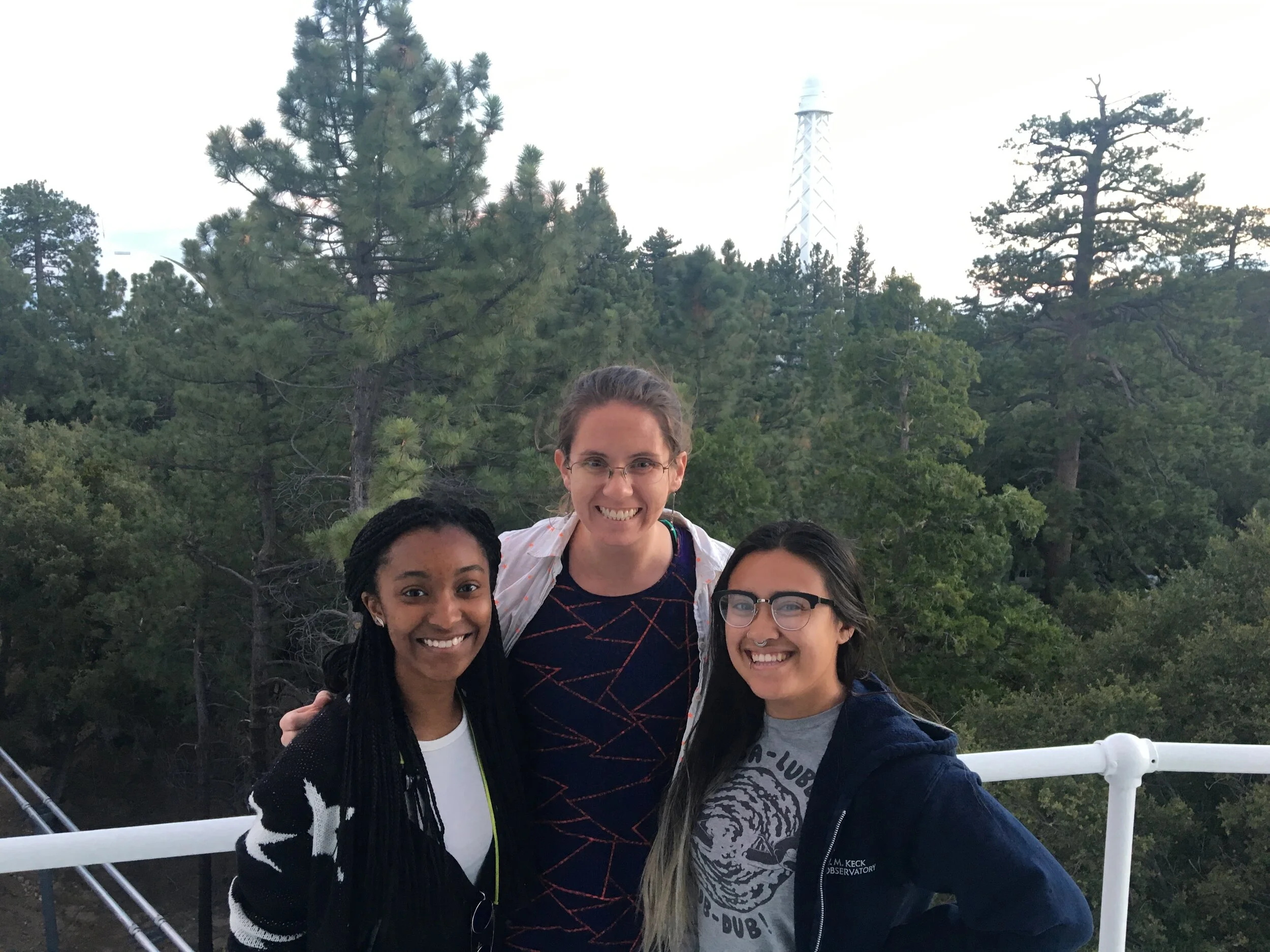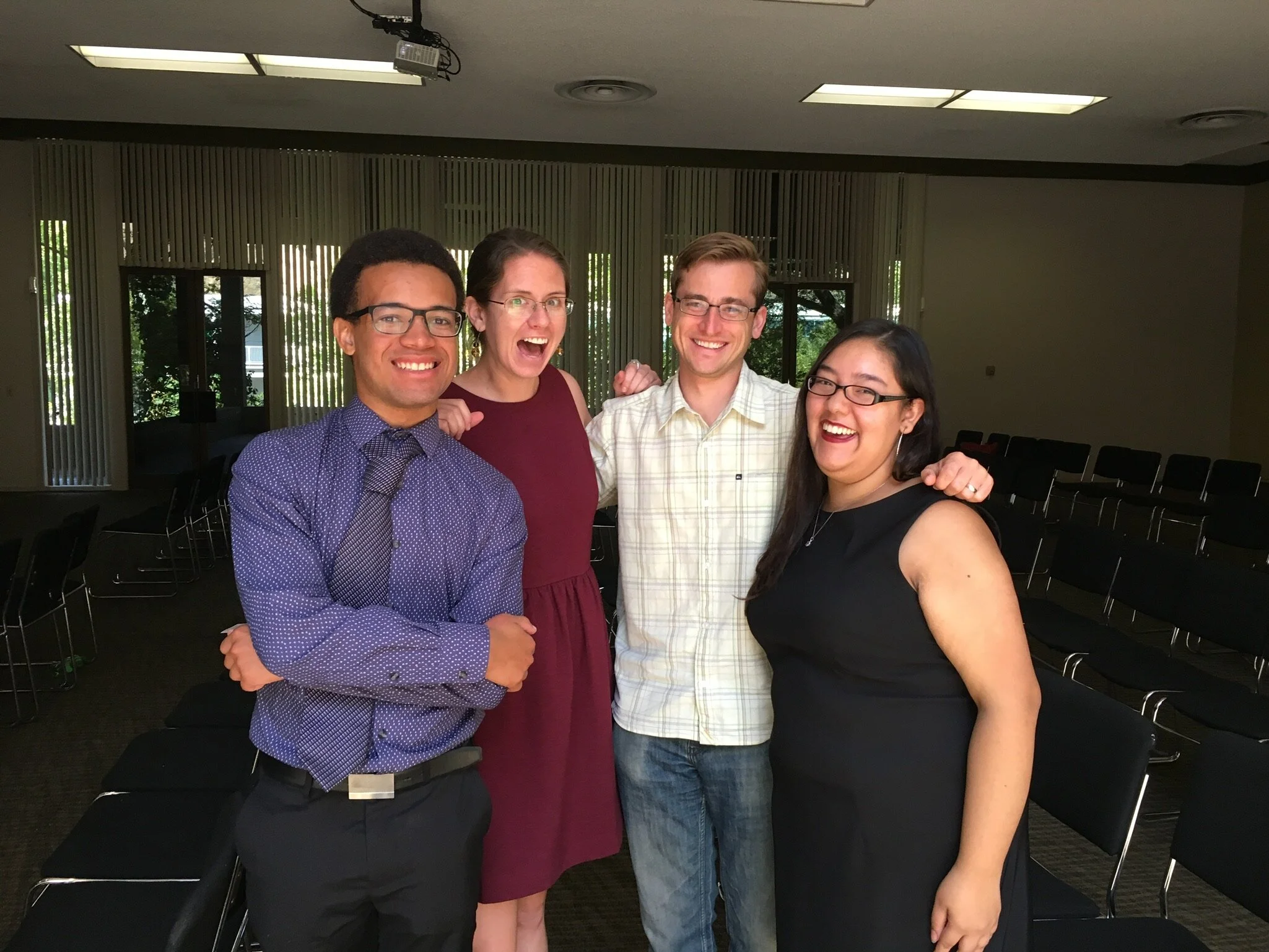Advising & Mentoring
As a staff member at Carnegie EPL, I have the great privilege and pleasure of working with outstanding postdoctoral scholars. Right now I’m working most closely with Dr. Munazza Alam, Dr. Shubham Kanodia, and Dr. Nicole Wallack. They are constantly teaching me, both about science concepts/content and the practice of science.
In the summer of 2022 I also organized and ran the Summer Undergraduate Internship Program (SURI), a “reboot” of past DTM/EPL internship programs. This paid internship brought seven undergraduates from local colleges/universities to our campus for 10 weeks of intensive hands-on research, field trips, and professional development workshops. You can read more about the internship program overall here, and read summaries of the interns’ Final Symposium presentations here. It was modeled very much on the Carnegie Observatories CASSI program, described more below.
SURI 2022 interns and me after the conclusion of their Final Symposium on August 5, 2022. From L-R: Maura Clark (UMD), Eran Driscoll (College of William & Mary), Nadya Abdul-Majid (Howard University), Shazali Audu (UMD), Chris Anto (JHU), Sarah Fong (UVA), and (on Zoom) Anirudh Hari (JHU).
In 2021, I was able to hire a short-term software developer to help with streamlining some observation preparation and planning tasks. Bryné Hadnott stepped into the totally-remote role and ran with it, making quick progress and bringing together several different tools (GoogleSheets, Trello, astroquery) with streamlined, user-friendly code. An interview about her position at Carnegie can be found here. Now Bryné works at Stanford’s Kavli Institute for Particle Astrophysics and Cosmology as a Scientific Data Curator and Storyteller, and continues to write regularly for the Women in Astronomy blog.
As a postdoc I worked with several students, all of whom also taught me a lot about asking questions, seeing problems from a new perspective, communication, and coding, among many other things.
In the summer of 2021, through the Carnegie Astrophysics Summer Student Internship Program (CASSI) at Carnegie Observatories, Pasadena, I remotely mentored undergraduate student Kendra Nguyen from Pomona College. We worked on comparing different predictions for the internal compositions of small planets, based on their masses and radii, focusing on planets in the sample from the Magellan-TESS Survey. Kendra and I kept working together after her internship ended, and she presented her results at the Summer 2022 AAS meeting in Pasadena, CA, where she received an Honorable Mention in the Chambliss Astronomy Achievement Student Award competition for her poster! Kendra spent the summer of 2022 as an intern at the SETI Institute, and is continuing her Physics B.S. at Pomona.
In the summer of 2019, although through CASSI, I worked with two undergraduate students, Cayla Dedrick of Caltech and Emmanuel Durodola of Cal State Northridge. Cayla was trying to find planets around metal-poor stars observed by TESS. This is a fairly unexplored parameter space in terms of host-star composition, because we've known for decades that some planets (giant ones) tend to prefer more metal-rich stars. But how much "metals" (anything beyond H and He, and maybe Li) are required to make a planet? This is what we were trying to explore. I co-mentored Cayla with Josh Simon of Carnegie OBS, and we also worked closely with Jessie Christiansen of IPAC/Caltech/NExScI.
Emmanuel's project was also related to exoplanet detection, but using radial velocities. He was investigating whether the residuals produced by Megan Bedell's wobble RV fitting package are related to stellar activity. Our hypothesis is that some absorption lines in the stellar spectrum change preferentially with time due to stellar activity, versus an orbiting planet (which affects all of the absorption lines via the "Doppler wobble"), and that wobble may not be completely fitting out those small changes.
Both Cayla and Emmanuel started graduate school in 2020, Cayla at Penn State and Emmanuel at Dartmouth. Both Cayla and Emmanuel are very capable and curious researchers, and it was blast to work with them!
Emmanuel and me during a visit to OBS in summer 2021.
Cayla with Josh and me during the CASSI end-of-summer symposium in summer 2019.
Over the summer of 2018 I started working with undergraduate Stephanie Striegel of San Jose State University on analyzing some high-cadence radial velocity observations taken with Magellan/PFS. The PFS team took these observations last year to help determine ``the best'' observing strategy in terms of exposure time and observation grouping, to achieve the best RV precision and increase our ability to detect planets. We have a guess at the answer, but no such empirical study has been done before on RV observations (this paper by Dumusque et al. was our inspiration, but uses ``synthetic'' RV measurements). Stephanie found some interesting results that she presented at the AAS in January 2019. She received an Honorable Mention for her NSF Graduate Research Fellowship application in 2019, and then worked as a Software Quality Operations Associate at Waymo LLC, formerly known as the Google self-driving car project. Stephanie just finished her Master’s at SJSU, and is working at NASA Ames.
Additionally in the summer of 2018, I started working with Erin Flowers, a graduate student at Princeton University. Carnegie Observatories has a great partnership with Princeton where graduate students can spend the summer doing research with someone at Carnegie. Erin is working on a project that has been on my list for years -- analyzing our iodine-free ``template'' spectra from PFS to derive stellar parameters, radii, and more detailed abundances. Look out for her comprehensive paper and interactive plots/database soon. Erin is also planning to graduate in 2023, so look out for her postdoc application!
From left to right, Erin, me, and Stephanie during our trip to Mt. Wilson with Upward Bound high school students in July 2018. This photo was taken on the catwalk of the 100'' Telescope, where Edwin Hubble made some of the most influential discoveries in astronomy.
Group photo at Carnegie Observaotries, after Erin and Stephanie's final presentations of the summer. They did great!
Over the summer of 2017 at Carnegie Observatories, I worked with Bryce Van Ross, an undergradute student from Pasadena City College, now at Cal State LA. You can see his end-of-summer research talk, summarizing his work on Gaussian process regression of stellar activity indicators measured from RV spectra, here. A few weeks after the summer program ended, Bryce was the only undergraduate to give a talk at ExSoCal in 2018! He also presented his research at the 2018 Winter AAS meeting, and interned at NASA Ames in the summer of 2018. Bryce completed his Masters of Science in Mathematics at Cal State LA in 2021.
From left to right, Bryce, me, Jeff Rich, and Cal State East Bay undergraduate student Aracely Cobos (another of our undergraduate interns over the summer in 2017), after Bryce and Aracely presented at the CAMPARE Symposium in August.
During all of 2017 I worked with Rachel Johnson, a post-baccalaureate from the University of Toledo, whom I met while she was interning at NASA Ames. Rachel recently accepted a graduate admissions offer in the Physics and Astronomy at the University of Denver, and her work appears in our paper about the effects of stellar companions on the exoplanet radius distribution here.
While at Carnegie DTM, in the spring of 2015 I worked with Ryan Hubbard from Howard University worked with me for a semester, after which he was accepted as a rising sophomore to the University of Wisconsin-Madison REU program. Now Ryan is a graduate student at in the University of Michigan Applied Physics program, so cool! In the fall of 2015 and spring of 2016 I worked with University of Maryland undergraduate Junellie Gonzalez Quiles in a year-long project (check her out below, preparing our experiment for the piston cylinder, and here!), after which she was accepted to the Cornell REU program to work on exoplanet atmospheres with Lisa Kaltenegger. After several more research positions and finishing her undergraduate degree in Astronomy, in spring 2019 Junellie was selected for an NSF Graduate Research Fellowship, which she took to Johns Hopkins to pursue a PhD in Earth and Planetary Science.
Applying to graduate school in astronomy can be scary and confusing, at least it was for me. I put together a presentation of information and tips about this process, as well as some great resources created by many others, here. I also suggest reading Dr. Chanda Prescod-Weinstein's posts here, here, and here.
One of the most influential experiences of my professional life was attending the Inclusive Astronomy meeting in June 2015 at Vanderbilt University. You can check out my Storify for more information and some of the discussions that occured at the meeting. I also keep a list of resources related to equity, inclusion, and diversity here.






